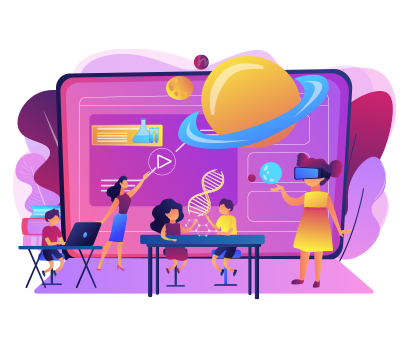Humans have always sought to transcend reality into worlds of our own. They have always wanted to merge these two realms. But that has been just a matter of imagination until now. We were incapable of physically experiencing this imagination through our senses. Then came the concept of Virtual Reality.
Virtual reality has made it possible to tailor our imaginative worlds to real ones. It lets us capture the imaginary senses, watch, feel, hear, and even experience things that never really exist in reality.
“VR technology market size is forecast to reach $92.31 billion in 2027.”
Virtual Reality is known and praised for its ability to transport the user into the digital realm. It lets the users interact with a computer-generated world using gestures and motions. The software simulation records the motions and gestures made by the user in the virtual world. This tangential effect is the sole reason that makes Virtual Reality in education such a natural fit. And hence, the technology is finding particular success by supplementing this much older and most essential industry – Education.
Virtual Reality in education has the potential to take learning beyond the conventional classroom experience. Some of the attractive reasons for its popularity are that it gives an enhanced experience, improved retention, and the ability to reduce common classroom distractions.
Before diving into how VR in education can help, let’s have a quick glance at the general concept of Virtual Reality.
This list is to help you navigate to the part of the post you want to read:
- What is Virtual Reality?
- VR in education
- VR in Education: Characteristics
- Where can VR in education be applied?
- Examples of VR in Education and Key Takeaways.
- Challenges that VR Faces and Problems that Needs to be Solved
- Stand out in the VR Education App Market with a Custom App
- Cost to Build a Virtual Reality Education App
- VR Education App Development
What is Virtual Reality?
NASA’s definition of Virtual reality is:
“Virtual reality is the use of computer technology to create the effect of an interactive three-dimensional world in which the objects have a sense of spatial presence”
Virtual reality is a 3D computer-generated interactive and immersive environment which a person can explore. The person exploring this virtual world becomes a part of it. This person can also manipulate objects of the virtual world or perform a series of actions to determine what happens, in the environment.
VR in education
Before getting into the details of how Virtual Reality in education will help improve the learning experience, it is important to understand the need to improve the quality of education.
Education builds a base for a thriving society. And the transfer of knowledge has been a topmost priority for humans. The Education industry has always looked for ways to make learning accessible to everyone in a quick and simple manner.
Therefore, many learning technologies aim at enabling this access to information and facts around the world to everyone. Before computers, we used books to retain facts. The rise in digital technology enables us to implement better learning with immersive technologies. Hence, VR in education seems to be the obvious evolution in the educational industry.
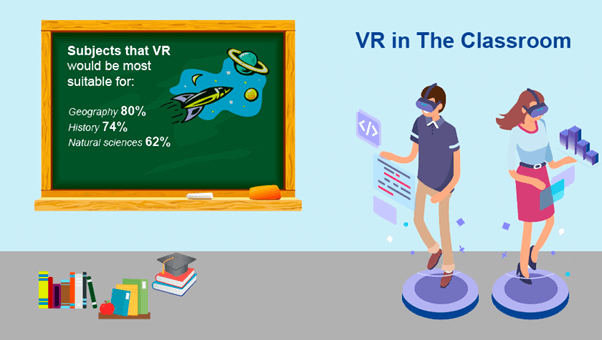
(Source)
Virtual Reality in education makes knowledge more easily available for people, and overcomes two significant problems:
1. Fact Retention: We can all agree upon the fact that being informed is not the same as being educated. Current education system is based on a rather old format. Learning and teaching methods just focus on providing facts. But consuming information is not enough. It is not the same as learning. VR solves this problem by giving a virtual ride for users to consume this information practically, making it more effective.
2. Systematic learning: Students generally face difficulties in understanding information. Sometimes, too much information becomes overwhelming for them. As a result, students get bored and disengaged from the whole learning experience. Therefore, VR in education is the need of the hour. VR can give a lively experience to keep students engaged. Almost anyone, at any time, anywhere can access it.
Although, education industry is yet to see widespread use of Virtual Reality, the future of VR in education is not bleak at all.
“53% survey respondents revealed that they plan to use VR in the near future. About 68% acknowledged that VR technology excites the students to learn.”
Hence the use of VR technology is expected to further engage young learners. Let us now have a look at the characteristics of VR in education.
VR in Education: Characteristics
VR in education works on the premise of creating a virtual world allowing users not only to see but interact with it. Being immersed when you’re learning, motivates people to understand and grasp quickly. Being immersed lessens the cognitive load and helps process the information easily. Let’s have a look at the characteristics of VR in education.
1. Gives a better sense of place
We all have had history classes where we had wished if we could be a part of some classic battles and revolutions of the past. All of us have at least once wondered how Einstein’s lab looked like or how the seven wonders of the world that we read about in our textbooks look like in real life.
But traditional learning experiences are limited to just scripts, descriptions, and text-book illustrations. VR in education helps us change this scenario. Thanks to the feeling of presence that it provides, students can easily learn and experience each and everything that they study. They can do this by living those experiences. While interacting through VR, a body actually believes that it is in a new place. This engages the mind in an exceptional way.
2. Scales Learning Experiences
Imagine practical experience using VR. Practical education similar to that of science labs can relatively improve upto a greater extent with VR in education. A small VR device can replace a science lab completely. Not only science, but VR devices are also scaling experience in learning fields. Students who play sports can closely experience their performance by looking at the recorded matches and studying it from every angle. History classes become more engaging and lively by taking students into the virtual realm of the past.
3. Do It Yourself
It is a well-known fact that people learn the best by doing things themselves. Current education systems involve very little learning that comes from students doing it themselves. Nowadays, students are only focused on reading theoretically rather than practicing things in real life.
VR in education provides an experience collaborative with theory. With VR education, students get enthusiastic to discover things by themselves. They get an opportunity to learn practically by doing rather than just reading. The best example of this characteristic could be a medical lab. Students can practice their medical skills with the help of these virtual experiences.
4. Emotional reaction
The fundamental form of making or forming memories are our emotional reactions pertaining to a certain set of information. How we perceive those reactions and emotions decides how we will remember it and for how long will we remember it. VR in education makes it comparatively easier to engage students the whole time, making learning and their experiences memorable.
5. Creativity Development
VR in education is not only limited to content consumption but also amazing for content creation. It allows students to boost their creativity by using powerful VR tools.
6. Visual Learning
VR in education helps visual learners up to a larger extent. Instead of reading about things, they can see things visually. This ability to visualize complex functions or mechanisms makes it easier to understand.
Where can VR in education be applied?
Let us have an in-depth look at the possible areas where Virtual Reality can be applied.
1) VR in Pre-School Education

- Developing Vocal Skills: Early literacy is affected by experiences that encourage speaking and listening. This includes everything from conveying simple needs to storytelling. The best way to build a vocational base is through real-world experience. VR enriches this experience with the help of additional immersive tools.
- Enhancing Real-life experience: VR can help in taking pre-school children to visit a park, zoo and other such places. VR learning extends this experience even after the field trip is over. Children can relive those experiences again and again.
2. VR in elementary schools
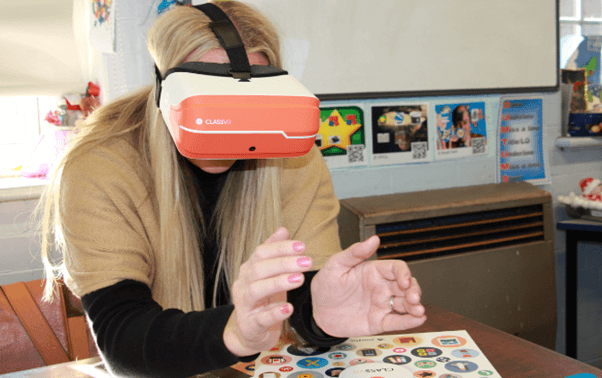
- In Context Learning: Creating contextual learning is crucial for building a deep understanding. Pre-elementary schooling phase is all about building a basic understanding of subjects and the world in general. VR can help strengthen this base by creating contextual learning. For example, learning about different phases of the moon in text-books is very different from roaming in space to study the moon experience with the latter one being the most preferred and immersive.
- Improve Retention: Engaging and immersive personal experience helps in information retention. The ability to remember VR experiences while learning a new concept is incredible and of particular benefit to students who struggle to remain focussed in a traditional classroom environment.
3. VR for kids with Special Needs
Many children with learning difficulties find the sensory immersion of a 360 video a comforting way to inculcate new concepts. They can also easily remove themselves from the situation if necessary.
4. VR in secondary school education
- Driving Engagement: The buzz and excitement of VR headsets in a classroom can build enthusiasm which nothing else can trigger. This improves the learning potential immensely.
- Developing Empathy: VR in education can give your students an opportunity to inhibit the perspectives of others. For example, imagine the understanding through the emotional experience of World War 2.
5. Virtual fields trips
Subjects like geography, history, and literature can be more interesting and enriching by immersive experiences through VR. Students can easily learn and grasp geography lessons by visiting any place on the globe virtually.
Google Expeditions is a good example of an app designed to provide a virtual field trip experience to its users. A library of various field trips is available for smartphone users. These trips include popular destinations from the Great Wall of China to Mars. People from across the world can virtually visit places, at any time. Google gave access to this app to thousands of schools across the world. This project was extremely successful. Google helped more than 1 million students in 11 countries and gave them the benefit of these expeditions.
6. Training and Internships
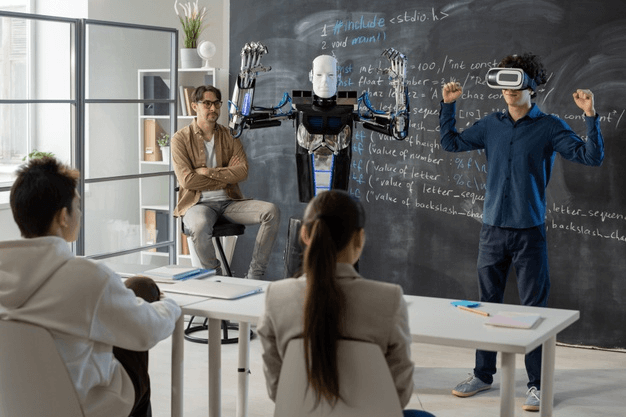
VR education solutions are highly advantageous for fields that require technical training. Some of them involve military training, the medical industry, and so on.
For medical students, VR can help them overcome problems like learning the anatomy of a body in three dimensions or study how different systems of the body fit together and work collaboratively. One such example of a VR education system is the one used by Mendel Grammar School in the Czech Republic. It helps biology students and anyone who wants to learn about the anatomy of the eye.
Students learn lots of things through internships. They receive the basic industrial experience through internships and VR can contribute in this area too.
7. Group learning
Group studies are an important part of student life and contribute to overall learning experiences. Group learning is one of the most effective ways to learn things as it involves collegiality and debate.
VR education can make this more immersive by allowing students to communicate with each other. Besides that, with the help of avatars and mapped facial expressions through the VR realm, people can come together to discuss, synthesize, and learn from each other.
8. Effective Distance learning
VR education solutions bridge the gap between teachers and students. It is helpful especially for those with distance learning programs. VR has the ability to put students and teachers in the same room. Everyone can have an immersive classroom experience.
Got Some Unique Features for your VR Education app idea?
Examples of VR in Education and Key Takeaways.
Many educational companies and institutes have adopted VR apps to boost their educational experience. We have also highlighted some unique features for you to get a better idea about your VR education app development. Here is a list of the most remarkable solutions of VR in education.
1. Discovery VR
The Discovery channel uses VR to provide a new immersive channel to the viewers. Viewers can enjoy exclusive 360-degree videos through a VR app. They can watch content related to nature, wildlife, space adventures, culture, history, environmental problems, and so on. Discovery VR is like a 3D YouTube for users.
Users can stream, save, and download videos as and whenever they want.
2. Orbulus
Orbulus is also a premier app with users from across the globe. It contains 3D, 360-degree images from all over the world. It contains the most marvelous locations from across the world. Users can find many famous locations on the app from Rockefeller Centre to Sydney Opera House. It has simple navigation that suits new users who have just started exploring virtual reality apps. The developers also encourage cooperation with photographers to promote this VR concept through images.
3. Bosch VR
This is a very specific example of VR apps built for a very precise and specific reason, in case you’re looking to build a similar app. Bosch VR is the perfect app for art lovers. It is also perfect for someone who wants to get acquainted with the world of “The Garden of Earthly Delights” by the famous Dutch painter, Hieronymus Bosch. The app was devoted to Bosch’s 500th anniversary. It helps users discover minute details of his most famous paintings.
4. Nanome
Yet another genre-specific example is Nanome. Nanome redefines the studies of the nanoworld. Nanome users can manipulate atoms designing macromolecules in real-time. They can then study and modify the results. The app boosts scientific research by focusing on collaboration and creativity. Using the app, users can free their minds from imagining and describing complex concepts.
Nanome is helpful for both research and learning. It is applicable to industries like pharma, organic chemistry, biology, and more. It is useful for subjects particularly related to molecular studies.
5. Anne Frank House VR
Yet, another classic need-specific VR app for learning. Force Field Entertainment is a large VR development studio. One of their projects includes Anne Frank’s diary. They have restored each and every detail from Anne Frank’s diary. This not only lets the users read but also experience history.
Users get a tour for around 25 minutes which shows Anne’s story. It is available in seven languages. Several organizations worldwide use this app for live educational experiences.
So these were the five most popular examples of VR education apps. Got a similar idea?
Challenges that VR Faces and Problems that Needs to be Solved
Currently, VR in Education is developing and is also facing problems that are far from unsolvable.
Firstly, it is not as practical as compared to other such concepts like Augmented Reality. Neither is it handy, nor is it that flexible if the live experience is not immersive enough. And surely it is not economical. According to a study by Stanford, people tend to get tired of wearing a VR headset in about eight minutes.
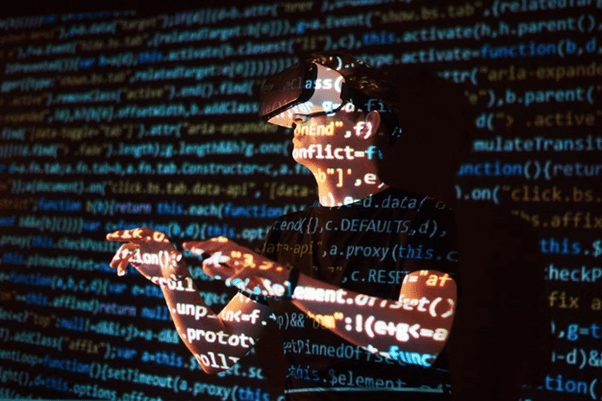
It also isn’t much comfortable for professional educators and learners to use cummbersome headgear. Another issue in its use-case is that it is not that easy to fix and it can easily cause problems to both learners’ learning experience and to educators as well.
The isolation issue remains. Perhaps isolation is the biggest drawback of VR solutions. People get isolated when using VR devices and their communication becomes limited. Vocal interaction inside the VR realm, if added to this, can prove a huge improvement too.
Developers from companies like Oculus are working hard to find a way to incorporate vocal interactions and access to social media platforms and networks. This eliminates the social barrier and allows people to attend social or educational events together. The distance limit would be gone and they can take part irrespective of wherever they are in the world or wherever the event is taking place.
Lastly, the video quality of 360 cameras is currently not good enough for the modern eye and hence needs improvement. The fact remains that Virtual Reality in education is here to stay and improve for both educators and learners. VR is a perfect match for education and learning. Multiple companies have already made a benchmark with their VR education apps. How will you make your app stand out in such a competitive environment? Here’s a trick.
Stand out in the VR Education App Market with a Custom App
Many business entrepreneurs opt for a clone app, because of the common perception of clone apps being reliable and cost-effective. But there are certain drawbacks of clone apps. As cool as the app cloning approach sounds, it is not practical enough. After all, an original is worth more than a copy.
The overall quality, and originality of mobile application takes a nosedive, because of cloning. Many app publishers face problems like up-charging, bad UI/UX, less scalability and poor functionality. Custom apps are an answer to the question of how to make your app unique. Hence, it is advisable to take the custom app route when you make a VR app. Here are a few benefits of custom apps in contrary to the drawbacks of clone apps:
Scalable: You can build custom apps from scratch and personalize it based on your business needs.
Functionality and Quality: Clone apps compromise the quality, be it in terms of functionality or appearance. Custom apps have the potential to deliver qualitative results because your app development project is in the hand of a professional developer.
User experience: Users always look for something unique. Unique features intrigue user attention up to a larger extent. In custom apps, it is easy to introduce new and innovative features to solve this problem.
Advanced Features: With the app cloning approach, you have to go with the existing features that are in the original app. No matter if you want it in your app or not. Take the customer app approach to get rid of this extra baggage of unwanted features.
Cost: You may think that creating a clone app is cost-effective and affordable. The quality of apps is quite low in clone apps. Therefore, trying to salvage your app built with clone software may cost you even more than a custom app.
iOS App Store Law for Clone Apps: Apple introduced a set of rules for its App Store against clone apps. They will reject the apps built through app generation services, or by commercialized templates. Custom apps have never faced such issues because they are original, and will never do!
So, these were the benefits of custom apps. Are you still hung up on low-cost clone apps? Well, the difference between custom and clone apps is not much. Can’t believe it? Read ahead.
Cost to Build a Virtual Reality Education App
We are a software developing company, and we’ll help you make your VR idea come to life. Biztech Consultancy assures you affordable pricing for successful execution of your Virtual Reality Education app idea with the latest features and appropriate monetization strategies. While calculating the actual cost of developing a Virtual Reality Education app for Android or iOS, the platform (Android or iOS) plays an important role. It affects the total number of hours of our expert developers. Without discussing more on the pricing of developing VR education apps, here is a brief analysis of estimation for a VR education app development.
- Developing a Native VR app (Android+iOS) will take 899 hours to have it fully functional. Also if you want to go for only one of these technologies, it will be 450 hours each.
- If you go with the hybrid technology it will take 795 hours to be precise which is 15% less than the native app development.
Apart from this, if you are ready with your details and want to build the app your way, then no worries! Our models are flexible and can suffice your requirements. You can check the detailed breakdown of features and hours below:
| Features | API | Native: Android + iOS (in Hrs) | Hybrid (in Hrs) | ||||
|---|---|---|---|---|---|---|---|
| Module Name | Design | Development | QA/UAT/PM | Design | Development | QA/UAT/PM | |
| Login and Forgot Passoword, Registration | 8 | 12 | 40 | 12 | 10 | 32 | 9 |
| Social Media Login | 2 | 0 | 16 | 4 | 0 | 13 | 3 |
| User Profile Management | 2 | 8 | 16 | 4 | 6 | 13 | 3 |
| Configuring the Virtual Space (boot check) | 12 | 16 | 24 | 12 | 16 | 20 | 9 |
| 360 Images for Screens* | 4 | 48 | 32 | 8 | 48 | 28 | 7 |
| VR Headset Authentication (Voice Password/Pin) | 2 | 4 | 16 | 6 | 4 | 14 | 5 |
| Interactive Dashboard (Various Modules to choose from) | 2 | 8 | 16 | 4 | 8 | 14 | 4 |
| MCQ Tour Creation | 6 | 12 | 32 | 6 | 12 | 24 | 5 |
| Short tip videos and rewards integration with MCQ | 4 | 6 | 16 | 6 | 6 | 12 | 5 |
| Watch and learn Tour Creation | 4 | 24 | 16 | 6 | 24 | 12 | 6 |
| Visualize data representaions and create Summary Tour Creation | 6 | 8 | 32 | 6 | 8 | 24 | 5 |
| Find the difference tour Creation | 2 | 16 | 24 | 6 | 16 | 20 | 5 |
| Spot the hidden items Tour Creation | 4 | 24 | 32 | 9 | 24 | 26 | 8 |
| Visualize theory concepts via video modelling and learn | 8 | 12 | 32 | 7 | 12 | 28 | 5 |
| Short test at completion of each tour | 6 | 12 | 24 | 6 | 12 | 20 | 5 |
| Learning Points and Rewards management | 8 | 16 | 32 | 6 | 16 | 24 | 5 |
| User wise Test reports Export | 4 | 8 | 32 | 4 | 8 | 28 | 4 |
| Replay the visited tours under your A/c and keep learning | 6 | 4 | 16 | 11 | 4 | 16 | 10 |
| 90 | 238 | 448 | 123 | 234 | 368 | 104 | |
| Total | Native: Android + iOS + API | 899 | Hybrid + API | 795 | |||
VR Education App Development
VR education apps are becoming a powerful tool that is changing the way we learn and teach. VR education use-cases are obviously going to increase in the next few years. VR education improves conventional learning concepts, so the impact in education will definitely grow. VR makes the conventional learning process an efficient, and immersive activity.
Virtual Reality in Education always had a big role in the imagined future. That future is here. With the VR growing at a faster pace, it would be utterly foolish to arrive late at this VR party. Choose an app and set out on a journey. Otherwise, by creating your Virtual Reality education, you can become a pioneer in the education industry with a brand-new concept.
Develop Your Virtual Reality Education app With Us
